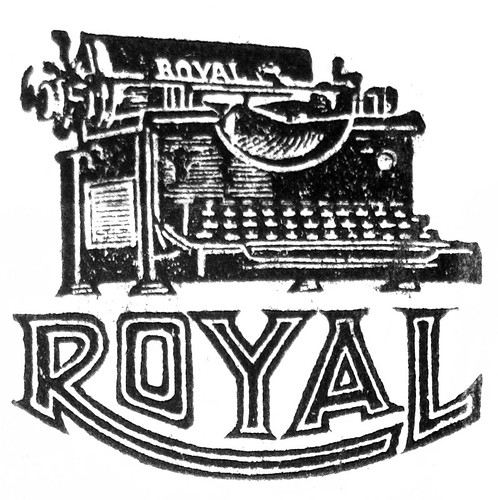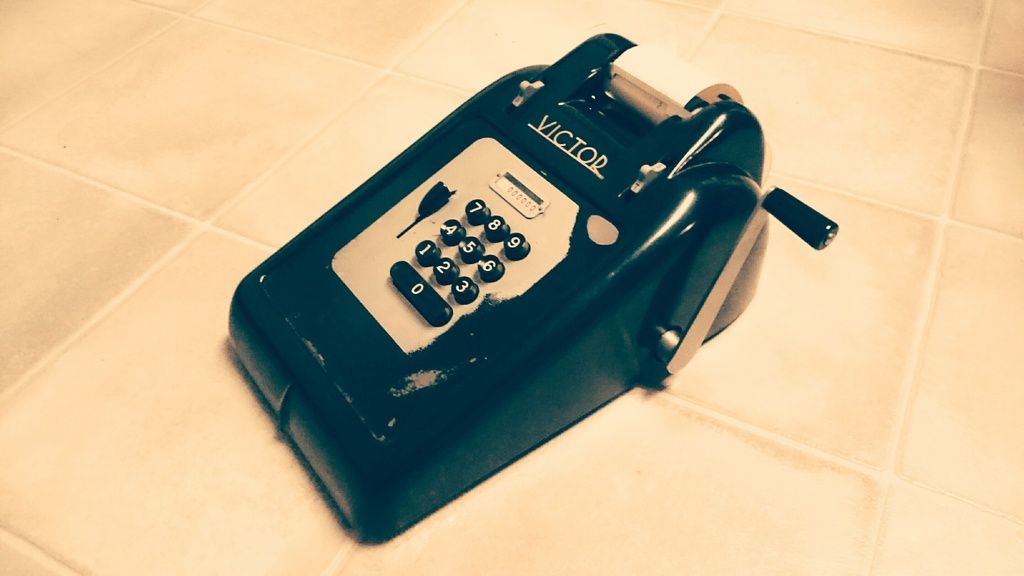
- TypewriterGuy
- Typewriter Talk Vet
 Offline
Offline 
- From: United States
- Registered: 24-4-2015
- Posts: 1,250
Re: Other Old, Mechanical Stuff...
The first one was the regular ABC layout, I beleive.
Back from a long break.
Starting fresh with my favorite typer. A Royal Futura!
- Spazmelda
- Key Master
 Offline
Offline 
- From: Ohio
- Registered: 25-2-2015
- Posts: 830
Re: Other Old, Mechanical Stuff...
Yeah, but qwerty was designed so the keys wouldn't jam as much. That's what I've always read at least. So, even through daisy wheels, word processors, computers, and iPhones/androids/tablets, that don't have any keys to jam, we still keep the same layout. More efficient layouts have been devised, but never really caught on.
My neighbor who brought me the Pencrest/smith-Corona a few weeks ago was telling me that she taught herself Dvorak and runs her computer with that layout. I was thinking you'd have to by a Dvorak keyboard, which are kind of expensive, but she just uses a setting on the computer and does it by touch. I've always wanted to learn it, so I may give it a try after the kids go back to school and the comouter is not monopolized by Sims.
Last edited by Spazmelda (02-7-2015 13:03:16)
- Uwe
- Moderator
 Offline
Offline 
- From: Toronto, Canada
- Registered: 12-3-2013
- Posts: 4,410
Re: Other Old, Mechanical Stuff...
Spazmelda wrote:
My neighbor who brought me the Pencrest/smith-Corona a few weeks ago was telling me that she taught herself Dvorak and runs her computer with that layout.
I wonder to what end? Does she type so fast that a QWERTY layout was limiting her speed? I type at an average speed, which for my purposes is more than fast enough, and the only other advantage that I've read Dvorak has over QWERTY is less chance of RSI, but apparently even that is a debatable point.
The pronoun I has always been capitalized in the English language for more than 700 years.
- Spazmelda
- Key Master
 Offline
Offline 
- From: Ohio
- Registered: 25-2-2015
- Posts: 830
Re: Other Old, Mechanical Stuff...
I don't know. I didn't grill her about her decision. She said she preferred it and not switch back. She did do a lot of keyboarding for her job
Last edited by Spazmelda (02-7-2015 15:35:40)
- Uwe
- Moderator
 Offline
Offline 
- From: Toronto, Canada
- Registered: 12-3-2013
- Posts: 4,410
Re: Other Old, Mechanical Stuff...
I wouldn't have "grilled" her either. I was just curious as to why someone would go through the effort of learning a new keyboard layout and thought maybe it would have come up in the conversation.
The pronoun I has always been capitalized in the English language for more than 700 years.
- Retro-Z
- Platen Punisher
 Offline
Offline 
- From: Central Kansas
- Registered: 25-5-2015
- Posts: 62
Re: Other Old, Mechanical Stuff...
Uwe wrote:
Well, that`s just it; QWERTY wasn`t the first typewriter keyboard and it was developed over years of trial and error testing using other configurations. With so much time invested in its development it comes as less of a surprise to me that the layout is still being used today. After all, we still use the wheel and when was that invented?
LOL. I didn't know I'd have to elaborate on that statement, but I'm fairly sure you understand what I was trying to say.
I should have said "the first keyboard to get widespread use in a regular production typewriter". Of course, I'm sure that statement can be picked apart, with people questioning the definition of "widespread" and "regular production", etc. In this instance, I'm talking about early Sholes & Glidden and Reminton typewriters from the 1870s, so you might try not over-analyzing what I'm trying to convey. These typewriters used a QWERTY style keyboard (yes, in some older machines, the setup was a bit different but still bear a striking resemblance to the QWERTY we use today).
Yes, I know the wheel works, but that is because it is still relevant. However, do you see a lot of cars running around on wooden or stone wheels? Technology evolves as the resources and needs change, and QWERTY isn't being kept around because it works well preventing jams in devices utilizing it.
Again, I find the use of the QWERTY keyboard on today's devices fascination. Maybe you guys don't see the same fascination, but that's OK. We all have our own interests and curiosities. Who knows... maybe I'm not completely sure why I find it so fascinating. ;-)
Last edited by Retro-Z (05-7-2015 01:07:13)
When you aren't looking for it... you ALWAYS find it!!!
- The Cabin Boy
- Novice Typer
 Offline
Offline 
- From: Baltimore, Maryland
- Registered: 08-4-2015
- Posts: 36
Re: Other Old, Mechanical Stuff...
Not many people know this, but before the Second World War Stoewer also made a line of exceptionally well-built automobiles. The factory wasn't very high-volume, and there are not a lot of Stoewers around, but from the photographs posted online, they were really cool looking cars for their day.
Rick
 "I'll wrestle you for that typewriter."
"I'll wrestle you for that typewriter."- BangoDeschain
- Novice Typer
 Offline
Offline 
- From: Iowa
- Registered: 08-12-2015
- Posts: 35
Re: Other Old, Mechanical Stuff...
Just picked this little guy up today!
- Repartee
- Key Master
 Offline
Offline 
- From: Brooklyn
- Registered: 12-10-2015
- Posts: 683
Re: Other Old, Mechanical Stuff...
Retro-Z wrote:
...
LOL. It's not that I feel QWERTY isn't a practical keyboard setup, I'm just surprised that over the course of 130 years we didn't come up with something different, despite several different keyboard configurations that were introduced. Who would've thought that the first typewriter keyboard would so permanently affect the way a keyboard is set up?
Think about it. Whenever someone inputs something into the most modern, 3+GHz quad-core processor based computer with a 1TB+ hard drive, they are typing that in on a basic keyboard layout created in the late 1870s. You gotta admit that is fascinating/interesting.
You know what's even stranger? While I am typing on my 3.0 GHz 8 GB Lenovo with a 64 bit OS (that's the best specs I can come up with) I am typing in English that is very close to the language used by the Elizabethans, and would even be mostly mutually comprehensible to Chaucer! We really ought to do something to modernize this a bit more. ![]() Considering that, it doesn't seem all that strange that we continue to use a keyboard layout developed in the 19th Century. We EVEN continue to use the 12 tone equal temperament championed by Bach in contemporary music! Ariane Grande sings in it!
Considering that, it doesn't seem all that strange that we continue to use a keyboard layout developed in the 19th Century. We EVEN continue to use the 12 tone equal temperament championed by Bach in contemporary music! Ariane Grande sings in it!
I don't know if it's a disadvantage or not, but Qwerty does give a work out to our left pinkie, most people's weakest finger. Lessened by electric typewriters and then computer keyboards, where evenness of touch is not particularly important so long as you press the darn key.
"Damn the torpedoes! Four bells, Captain Drayton".
- JoeV
- Touch Typist
 Offline
Offline - Registered: 11-4-2015
- Posts: 152
Re: Other Old, Mechanical Stuff...
Speaking of alternative keyboards, when I had a Palm OS PDA (remember those?) I outfitted it with an alternative stylus-entry keyboard software called Fitaly, so named for the middle row of letters. It had a square layout and was optimized for single-stylus entry, where the most common letters are near the middle. I got to be pretty quick with Fitaly for note taking, faster than using the Palm graffiti scrawl.
I've always thought Fitaly would make a good smart phone keyboard for texting.
~Joe


